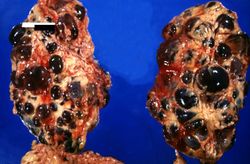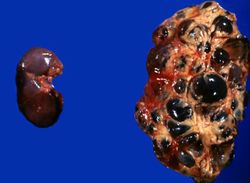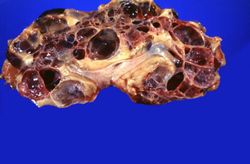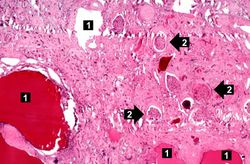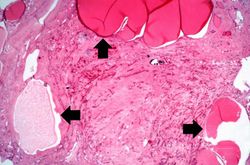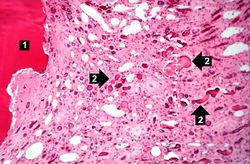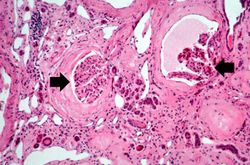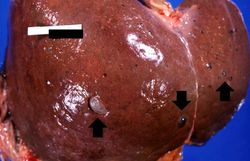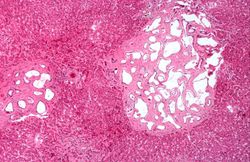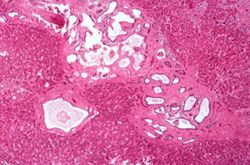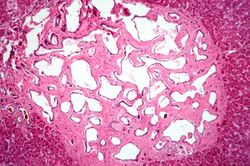IPLab:Lab 5:Polycystic Kidney Disease
Contents
Clinical Summary[edit]
This 64-year-old white man had a history of hypertension, adult-onset diabetes, gouty arthritis, chronic obstructive pulmonary disease (COPD), chronic anemia, bleeding from colonic polyps, and bleeding from gastric ulcers. The patient was in end-stage renal failure due to polycystic kidney disease and he required renal dialysis. His mother and a brother both died from renal complications.
His terminal admission was for congestive heart failure and ventricular tachycardia. He underwent a coronary artery bypass grafting (CABG) operation after which he was ventilator-dependent. Two days after the operation he developed pneumonia and died.
Autopsy Findings[edit]
The lungs were diffusely consolidated with some abscesses in the right upper lobe. The kidneys were markedly enlarged. The right kidney weighed 1660 grams and the left kidney weighted 1780 grams.
Images[edit]
Virtual Microscopy[edit]
Study Questions[edit]
Additional Resources[edit]
Reference[edit]
- eMedicine Medical Library: Polycystic Kidney Disease
- eMedicine Medical Library: Cystic Diseases of the Kidney
- Merck Manual: Overview of Cystic Kidney Disease
Journal Articles[edit]
- Bajwa ZH, Gupta S, Warfield CA, Steinman TI. Pain management in polycystic kidney disease. Kidney Int 2001 Nov;60(5):1631-44.
Images[edit]
| |||||
Renal failure is the severe reduction of renal function and often leads to reduced urinary output.
In alcoholics, aspiration pneumonia is common--bacteria enter the lung via aspiration of gastric contents.
Consolidation is the filling of lung air spaces with exudate--this is a sign of pneumonia.
An abscess is a collection of pus (white blood cells) within a cavity formed by disintegrated tissue.
A normal kidney weighs 157 grams (range: 115 to 220 grams).
A normal kidney weighs 157 grams (range: 115 to 220 grams).
Pericarditis is inflammation of the pericardium - often with deposition of fibrin.
